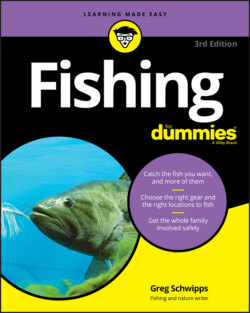Читать книгу Fishing For Dummies - Greg Schwipps - Страница 71
How to fish the water
ОглавлениеThe size of any large body of water is intimidating. Don’t let it be. Whereas boats offer anglers the advantage of covering more water, most lakes and reservoirs offer shore-bound anglers some bank access. Some even feature fishing piers, often with sunken brush piles nearby to attract fish. Fishing any lake or reservoir calls for ruling out the fishless water. The fish population won’t be distributed equally over the acres, so whether you’re fishing from boat or bank, seek out cover or interesting structure. A point could attract fish, especially if it provides cover, too. A bank with a rocky ledge will usually lure fish. A bridge over a lake will often appear in a narrower area where the banks are closer together and may feature banks of riprap (large stones or chunks of rock) to control erosion. Pay attention — the land above the water line provides clues about the bottom. A sharp rising bank usually means the water is deep below the surface, because the bottom will fall away just as steeply. Fish will be drawn to edges, or differences — where one bottom type meets another (say where a sandy bottom becomes rocky, or where a weed bed stops).
Generally, fish will be in shallower water in the spring, seeking warmer water (the sun warms shallower water faster) and potential spawning sites. As the summer progresses, fish move into areas offering the right structure and cover spread out around the lake, and as fall approaches, fish tend to move to deeper sections of the lake or reservoir. Usually, the closer you are to the dam, the deeper the water will be. Plan your location around the season and you’re on the right path.
If mobility is possible, don’t fish too long in one spot. Move and learn more about the water.
